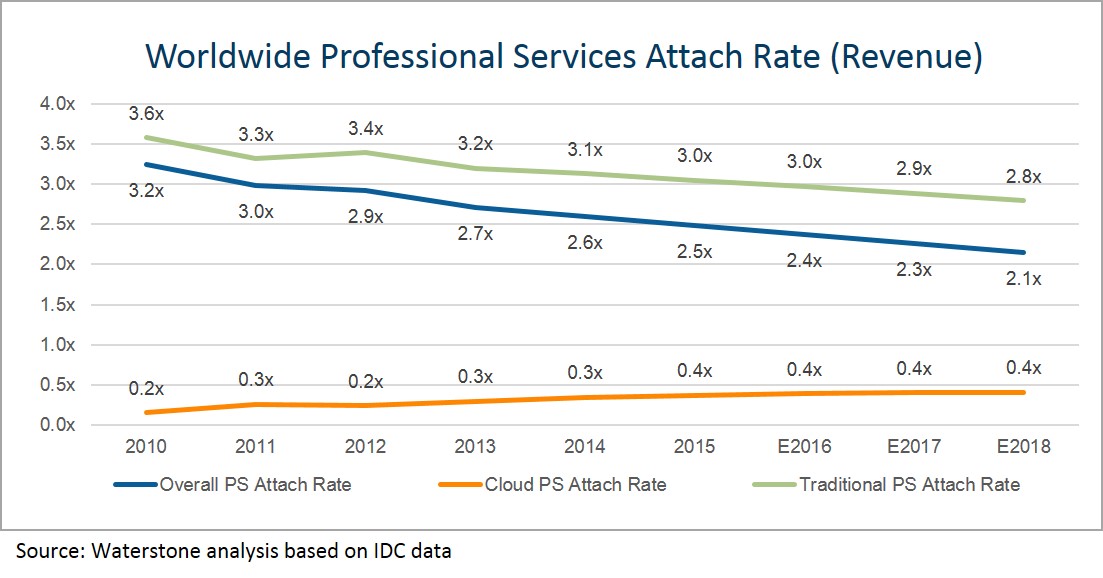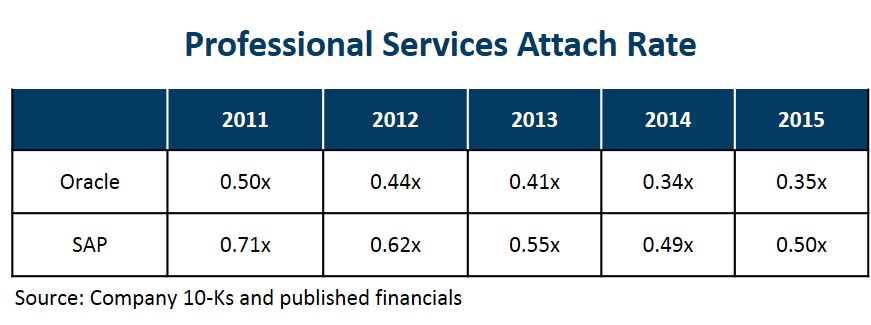 Software’s $700 billion Professional Services (PS) market, which includes everything from systems integration to software deployment to network consulting, is in the midst of a rapid spending and value shift driven by the industry’s continued migration to the cloud and subscription-based models.
Software’s $700 billion Professional Services (PS) market, which includes everything from systems integration to software deployment to network consulting, is in the midst of a rapid spending and value shift driven by the industry’s continued migration to the cloud and subscription-based models.
While the overall PS market is increasing, it is doing so at a slowing growth rate of three percent. At the same time, $40 billion of annual new professional services is being created to support software’s migration to cloud-based solutions. This spending and value shift has major implications for enterprise software companies, which traditionally earn 15 to 20 percent or more of total revenue from professional services. It also has significant implications for third-party PS providers, which typically account for two-thirds of the PS market.
Understanding the cloud shift and the opportunity it presents
The trends impacting software today are also affecting the professional services that go with that software. Cloud software allows customers to leverage best-in-class functions and features, and it is easier to use and access. Customers also expect faster, easier and less-expensive implementations as well as a steady stream of high-value, low-cost (or no cost) upgrades.
At the same time, the market shift to the cloud has triggered increased demand for professional services. This new market growth opportunity is on the table for those software companies and third-party PS providers that are able to provide cloud consulting and integration services. However, to effectively capitalize on this market shift, providers must understand why the overall rate of PS growth is declining and proactively plan and act to address these new market dynamics.
Rethinking professional services economics
Professional services are commonly measured in terms of a PS attach rate — the ratio of PS bookings to the total software licensing/subscription bookings for a given licensing/subscription event.

For example, if $125,000 of professional services are booked to configure and install $50,000 of contracted software licenses or subscriptions, then the PS attach rate would be 2.5x ($125,000 / $50,000).
In recent years, the overall PS attach rate has been progressively decreasing — a trend that will continue. From Waterstone’s analysis of the global software industry, the overall PS attach rate, including both software companies and third-party service providers, fell from 3.2x in 2010 to 2.6x in 2014. By 2018, it is estimated to fall to 2.1x.

Two major themes are driving this continual drop in PS attach rate:
- There is growing preference for cloud- and SaaS-based solutions that, on average, have a PS attach rate around 0.5x to 1.0x (versus the 2.9x commonly seen with traditional licensed products). In 2010, these solutions accounted for less than 10 percent of worldwide commercial software licenses and subscriptions. By 2014, their share of the market had grown to 19 percent, with a go-forward growth rate of 30 percent projected for 2014 to 2018.
- Traditional on-premises software is becoming easier to implement, configure, install, etc., resulting in a slowing growth rate of just over two percent for this segment of the PS market.
While the 0.6x decrease in overall PS attach rate from 2010 to 2014 (3.2x to 2.6x) may not seem dramatic at first glance, it needs to be viewed in the context of worldwide software sales. For 2016, worldwide commercial software new licenses and subscriptions are estimated to land around $300 billion; a 0.6x PS attach decline applied to $275 billion results in more than $180 billion in PS revenue that is no longer available to the marketplace. That’s not to say that the PS market is shrinking — it is growing in tandem with new licenses and subscription sales, albeit at a slower rate.
The decline in overall PS attach rate may not be as severe as expected if the cloud-based PS market grows more rapidly than is currently projected. As software providers broaden their offerings and develop ecosystems, there is room for value-added services to grow as well. One example of this is the Salesforce ecosystem, which includes a vast number of third-party add-on services that are available post-implementation. Analyst estimates have put the size of Salesforce’s third-party services ecosystem at around $6 billion annually, which nets a PS attach rate approaching that of traditional software products.
Planning and acting on the professional services shift
Software companies with a PS arm should look to reset expectations around traditional PS revenue and margins. With professional services typically accounting for 15 to 20 percent of total enterprise revenue, a declining PS attach rate can have significant implications to the organization’s overall performance. We’re seeing this decline across the broad spectrum of software companies regardless of size, industry or age. This is clearly evident in the software bellwethers, which have experienced a decline in PS attach rate over recent years, including SAP and Oracle.

Beyond the numbers, a reduction in professional services may result in less customer interaction at a critical point in the relationship’s formation. The PS organization is central to managing and driving the customer experience; a positive first interaction or PS experience can lay the foundation for a long-term, mutually beneficial relationship. Furthermore, quality PS onboarding and implementation services present an opportunity to get a thorough understanding of the customer’s business — surfacing ways to provide additional value-added software and services.
Gain deeper insight through the Professional Services Value Equation (PSVE)
To fully understand the impact that the shift to the cloud will have on professional services and the organization as a whole, software companies must dig deeper than the PS attach rate. For this, Waterstone recommends using the Professional Services Value Equation (PSVE), which augments the standard PS attach rate with professional services’ impact on driving post-sales upsell/add-on software and services (add-on attach) and on increased customer retention and overall customer satisfaction/referenceability (customer success attach).
PSVE = Standard PS Attach Rate + Add-on Attach + Customer Success Attach
To illustrate by example, assume a software provider has $300 million in annual PS implementation and onboarding revenue attached to $200 million in combined on-premises and subscription revenue, resulting in a 1.5x standard PS attach rate. Now assume the following:
- Software revenue contribution: Of the $200 million in combined revenue, $100 million is on-premises revenue and $100 million is subscription revenue.
- Standard PS attach: Implementation services have declined from $300 million to $250 million, resulting in a corresponding reduction in a standard PS attach rate of 1.5x to 1.25x.
- Add-on attach: $40 million in software and services were sold as an add-on after implementation, equating to an add-on attach rate of 0.2x ($40 million / $200 million).
- Customer success attach: Improved customer success services have resulted in a six percent reduction in the annual customer churn rate, contributing $6 million in new revenue (six percent x $100 million of subscription revenue). This translates to a customer success attach rate of 0.03x ($6 million / $200 million total on-premises and subscription revenue).
Given the above assumptions, the PSVE score is calculated as follows:
Standard PS Attach Rate + Add-on Attach + Customer Success Attach = PSVE Score
1.25x + 0.2x + 0.03x = 1.48x
If the software company looks solely at the standard PS attach rate at a point in time (initial implementation/onboarding), the company misses the value (and revenue impact) that professional services can/should provide over the customer life cycle. However, if the company measures and acts upon the more comprehensive view of professional services’ impact on the company’s customers and revenue as measured by the PSVE score, then the company is leveraging professional services to create value — for the customer and the software company.
Capitalizing on the professional services shift
The software industry’s increasing migration to the cloud will continue to impact and challenge PS organizations, whether they service subscription-based products, licensed products or a combination of the two. Software companies that have an in-depth understanding of their current PS attach rate and measure and act on their PSVE score will create the most value for their customers and their enterprises from this market shift.
Mark Hauser is managing director and founder of Waterstone Management Group LLC. He has extensive market and operating experience in the technology industry and related business services on a global basis. Mark specializes in operations strategy and improvement, and corporate development in the software and services segment within the technology industry. Contact him at mhauser@waterstonegroup.com.
Andrew Loulousis, manager at Waterstone, also contributed to this article. Andrew advises clients on a number of key strategic issues including growth planning, operations improvement, outsourcing, new product design and launch, customer success strategy and design and acquisition diligence. Contact him at aloulousis@waterstonegroup.com.
